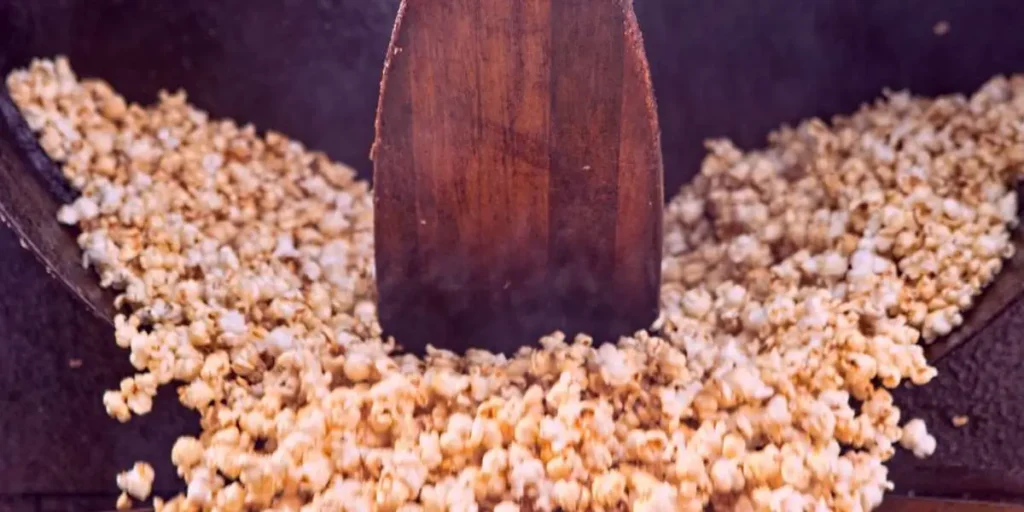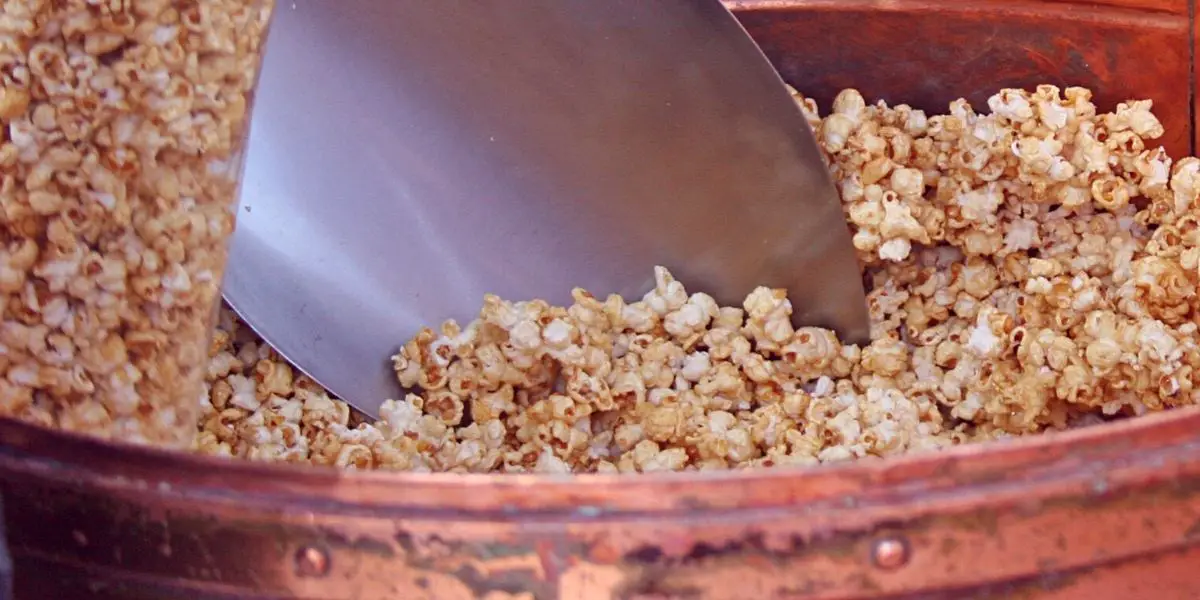It’s easy to assume that kettle corn and popcorn are the same thing, but they are two truly different types of snacks. While both are a type of popcorn, the way they are cooked, the way they taste, and their nutritional value all vary quite a bit.
What Is Kettle Corn?
Before we go into more detail about these two types of popcorn, here is the main difference between the two:
Kettle corn is always a sweet popcorn, while regular popcorn can be any flavor and can even be cooked plain without any added salt or butter.
Is Kettle Corn Healthier Than Popcorn?
It is often tricky for kettle corn to be healthier than regular popcorn, but it is not impossible. Usually, kettle corn is made not only with sugar but also with a little bit of salt and butter so that the balance of flavors is a little more even.
Regular popcorn, on the other hand, can be air-popped and eaten plain, which makes it healthier than kettle corn.
Since regular popcorn can also be soaked in butter and oil, it can actually be worse for you than kettle corn.
The bottom line is this: if you read the ingredient lists for anything you add to the popcorn while you’re making it, and after it’s cooked, you can make both kettle corn and regular popcorn relatively healthy. It’s just a matter of reading your labels and trying to go with the ingredients that have the lowest amounts of sugar, salt, saturated fat, and cholesterol, among other things.
If you pay attention to everything you’re using to cook and season both kettle corn and regular popcorn, you can always find a way to make it a little healthier if you like.

How Is Kettle Corn Different From Popcorn?
When looking at kettle corn vs. popcorn, there are many differences. Let’s start with a few of the basics. First of all, kettle corn:
Check out our article on how to choose a stovetop popcorn maker to help you make kettle corn.
On the other hand, regular popcorn:
Is Kettle Corn Healthy to Eat?
As a general rule, kettle corn is not the unhealthiest snack on the planet, but that all depends on what ingredients you use for cooking and seasoning it. If you use sea salt instead of regular table salt and use healthier oils, you can cut down on the unhealthy ingredients typically found in kettle corn.
Keep in mind that kettle corn will always contain sugar, and sugar is not exactly good for you. Nevertheless, if you use a little less sugar and the other ingredients you’re using are organic and healthier, kettle corn doesn’t have to be that bad.
Is Kettle Corn Hard to Digest?
All popcorn, including kettle corn, is whole grain and contains lots of fiber. We don’t actually digest fiber but instead, it pushes through our digestive tract to keep us regular and healthy.
A one-cup serving of popcorn contains about one gram of fiber, so eating popcorn is a great way to increase the fiber you get in your daily diet. Since most people don’t get enough fiber daily, popcorn is an excellent food to add if you’re frequently constipated.
TIP – If you’re not used to eating a lot of fiber, and you suddenly start eating large amounts, it can be bad for your stomach and cause gas and bloating, among other symptoms.
The best thing to do if you’re interested in adding popcorn to add more fiber to your diet is to add these foods slowly so that you’re not eating too much fiber at once. Once you get used to having more fiber in your diet, you can increase it slowly until you’re getting enough fiber on a daily basis.
What About the Nutritional Content?
The nutritional content of kettle corn vs. popcorn varies, again, depending on how it is cooked and seasoned. When you compare these two types of popcorn, kettle corn always has more sugar. If you have high blood sugar, this is something you’ll have to consider when you’re trying to decide between these two types of popcorn.
On the other hand, when comparing kettle corn to the popcorn sold in movie theaters, its saturated fat content is much lower.
If you air pop your popcorn and add only a touch of salt, it is very healthy, especially because popcorn is high in fiber and antioxidants. The air-popped type of popcorn is also lower in calories and sugar than kettle corn.
On the other hand, when you compare any type of popcorn, or even kettle corn, to the popcorn served in movie theaters, there is no comparison. Almost any type of popcorn is healthier than the popcorn sold in theaters
Why? Because movie theater popcorn is almost always filled with butter or margarine, salt, and lots of flavorings. It also contains roughly 30 grams of saturated fat, which is almost a two-day supply of fat for most people. Of course, you should also keep in mind that adding unhealthy ingredients to any type of popcorn doesn’t take away its positive nutritional benefits. It merely adds things that aren’t so good for you but make it taste good.
Popcorn, in other words, is filled with all types of nutrients on its own. Its preparation and seasoning methods will determine if the final product is good for you or very unhealthy, and that part is entirely up to you.
FAQs Kettle Corn Vs Popcorn
What is the main difference between popcorn and kettle corn?
The main difference lies in the flavors and preparation methods. Popcorn is a traditional snack made by popping corn kernels, while kettle corn is a sweet and salty variation that involves popping the kernels in a kettle or pot with sugar and salt.
How does the taste of popcorn differ from kettle corn?
Popcorn has a neutral taste with a light and crispy texture. On the other hand, kettle corn has a sweet and salty flavor profile due to the addition of sugar and salt during the popping process.
Are the popcorn kernels used in popcorn and kettle corn the same?
Yes, the popcorn kernels used in both popcorn and kettle corn are typically the same. They are varieties of corn that have been specifically cultivated for popping.
Can I make kettle corn by simply adding sugar and salt to regular popcorn?
While you can add sugar and salt to regular popcorn, it won’t result in authentic kettle corn. The process of making kettle corn involves specific techniques and equipment, such as using a kettle or large pot to pop the corn and evenly coating it with sugar and salt.
Is kettle corn healthier than regular popcorn?
In terms of nutritional value, kettle corn and regular popcorn are similar. However, due to the added sugar in kettle corn, it tends to have a slightly higher calorie and carbohydrate content compared to plain popcorn. It’s important to consume kettle corn in moderation as part of a balanced diet.
Can I find kettle corn at movie theaters or only at fairs and festivals?
Kettle corn is not as commonly found at movie theaters as regular popcorn. However, it has gained popularity over the years and can be found at certain theaters or concession stands that offer a variety of popcorn flavors.
Are there any other flavors of kettle corn available?
Yes, besides the traditional sweet and salty version, you may find various flavored kettle corn options. These can include caramel, chocolate, cinnamon, or even spicy variations, offering a wider range of taste experiences.
Can I make kettle corn at home?
Absolutely! There are numerous kettle corn recipes available online that provide instructions on how to make it at home. You’ll need a large pot or kettle, popcorn kernels, oil, sugar, and salt to replicate the delicious sweet and salty flavor.
Does kettle corn have a longer shelf life than regular popcorn?
Both kettle corn and regular popcorn have a relatively long shelf life if stored properly in airtight containers. However, it’s always best to consume them within a reasonable time frame to ensure freshness and the best taste experience.
Which one is more popular: popcorn or kettle corn?
Popcorn is generally more popular and widely consumed than kettle corn. Popcorn is a classic snack enjoyed by people of all ages and is readily available in movie theaters, sporting events, and grocery stores. However, kettle corn has gained popularity in recent years and is often associated with fairs, festivals, and specialty popcorn vendors.
Final thoughts 💭
Regular popcorn can be fixed in any number of ways, and these are just a few of the differences between kettle corn and regular popcorn. Kettle corn also produces a caramelized flavor because of the mixture of sugar and salt. While you can add some sugar to regular popcorn, it will never be as sweet as kettle corn is.
Your preference for one of these popcorn types or the other will depend on how you want it to taste and how healthy you expect it to be. You certainly have more control over what to add and what to avoid when it comes to regular popcorn, but you sure can’t beat the taste of homemade kettle corn.
It’s really up to you which type of popcorn you want to eat. They each have their pros and cons, so your preferences and tastes can help you decide which one is right for you.
Kettle corn is excellent for people who love their popcorn sweet, but making it is a labor-intensive process, mainly because you have to constantly stir it, so the sugar doesn’t burn.
Curious to know the differences between Kettle Corn and Caramel Popcorn?







Leave a Reply